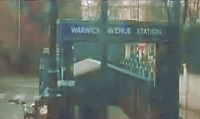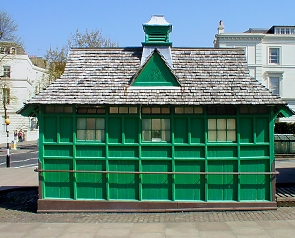A broad, stuccoed street in southern Maida Vale, running north-westwards
from the Harrow Road at Little Venice to Sutherland Avenue. This was originally a track called Green Lane and was named Warwick Road (later changed to Avenue)
on the street plan produced in 1827 by George Gutch, surveyor to the Bishop of London. Gutch named the road after Jane Warwick,
of Warwick Hall near Carlisle, who had married into a landowning family here in 1778. The first houses, some of which were
very large, were erected in the 1840s by the Warwick Avenue bridge over the Paddington arm of the Grand Junction (now Grand
Union) Canal. The neighbourhood was largely built up within two decades and most of the properties survive today. St Saviour’s
Church on Warwick Avenue was consecrated in 1856 and its section of the road was widened to create a grand approach, making
this perhaps the broadest avenue in London. The church, however, was never wealthy, partly because the area acquired such
a large Jewish community. With all this development, nearby Welford’s dairy, dairymen to Queen Victoria, had to send
its cattle to fields in Willesden and Harlesden and the dairy building relocated to new premises at the corner of Shirland
Road and Elgin Avenue in 1882. One of London’s few surviving cabmen’s shelters was built on the avenue around
this time. Warwick Avenue station opened in 1915 as an intermediate stop on the Bakerloo Line’s new extension from Paddington
to Queen’s Park. The station was originally to have been called Warrington Crescent and it is perhaps surprising that
it has not since been renamed Little Venice. St Saviour’s Church was rebuilt in 1976 in a project that incorporated
the new flats of Manor House Court. There are shops on Formosa Street, which crosses the northern part of the avenue.
 |
 |
|
|
|
 |

|
| Warwick Avenue cabmen's shelter |
David
Ben-Gurion, the first prime minister of Israel, lived at 75 Warrington Crescent in 1920. Early punk musician Matt Dangerfield
converted his basement flat on Warrington Crescent into a recording studio in the mid 1970s. The Damned, The Clash, Generation
X and the Sex Pistols are said to have made their first recordings here.
Duffy’s 2008 single ‘Warwick Avenue’, taken from the album Rockferry,
was a major international hit. The song’s video (from which the frame below left was captured) featured the Welsh singer-songwriter
leaving Warwick Avenue tube station in a black cab and a flood of tears.
|
 |
|
|
|

